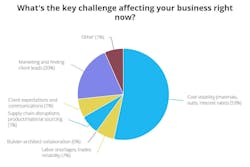What We’re Tracking Now: Trends, Moves & Signals On Our Radar
Each week, we scan the horizon of luxury residential design and construction to surface early signs of change: shifts in business, strategy, materials, or just mindset.
CB Signals is where we collect the small things that may become big things, like an architect's offhand comment or a subtle change in client expectations. Some trends are still whispers, of course. But we think they're all worth tuning into.
Signal > Builder-Friendly City?
Is Denver Prototyping a New Model for Builder-Friendly Cities?
At the Urban Land Institute’s Spring Meeting, the City of Denver laid out a permitting promise builders don’t hear every day. Mayor Mike Johnston said:
“For every project in the city, from development plan through permitting, we made a public commitment that we will get you through that entire process in 180 days—which used to be a two- or three-year-long process—and if we don’t, we pay you back $10,000 of the permitting fees that you paid to start the project.”
That kind of guarantee signals a shift in how Denver sees its role: less gatekeeper, more partner.
It’s part of a broader push, including a $570 million public/private investment package aimed at residential conversions, downtown improvements, and drawing more people back to the city center. Johnston framed it as part of a big picture effort, where “Denver is going to be the best city in America to do business.”
Our take: Permitting remains a pain point nearly everywhere. While we wouldn’t call this a trend yet, Denver’s approach stands out and may push other cities to rethink how they work with builders.
Signal > Market Pressures
We recently asked our readers to weigh in on their biggest business challenge—from cost volatility (materials, subs, etc.) to client leads, collaboration, and more. Here's what they said:
While it’s no surprise that cost volatility remains the biggest challenge custom builders face, what’s more notable is how low concerns were around labor shortages (see below for our take on that) and on supply chain disruptions. These are two issues that have dominated headlines, so we’re wondering if this is a sign that conditions may be easing or if they vary regionally.
Also interesting: sustainability and architect collaboration barely register as current pain points, suggesting builders aren't feeling pressure here. Marketing and client lead generation continue to be a steady challenge.
Does this reflect what you’re seeing? We’d like to hear your take. Send us a line.
Signal > Workforce Development
Builders Can (and Should) Fill the Gap
As Washington debates workforce funding, including proposed cuts to Job Corps, builders are taking matters into their own hands. With the industry falling short a reported 400,000 construction workers, more are looking locally for solutions.
At last week’s NAHB Spring Leadership Meeting, the Professional Women in Building council announced a new strategic partnership with SkillsUSA, a step toward strengthening the pipeline from schools to job sites. Workforce development was a recurring theme throughout the meeting, with calls for builders to look locally for solutions.
Some great models to consider:
- In Charlotte, N.C., the Rebuilding Opportunities in Construction (ROC) program works across four high school campuses to help students earn dual enrollment credits, complete national certifications, and learn from field experts through paid internships.
-
In Charleston, S.C., the American College of the Building Arts, which launched 20 years ago in response to a shortage of skilled craftspeople after Hurricane Hugo, continues its mission to train artisans in traditional building trades.
-
And in Roanoke, Va., the Build Smart Institute, founded by a local contractor, offers fast-track programs to train new construction workers with real-world skills. Last year, the program enrolled 160 students who earned 140 professional certificates.
Our take: These aren’t new efforts, but they're still rare. The clear message from last week's NAHB meeting? You don’t need to launch your own program; even small actions make an impact: Call a local teacher. Donate excess materials. Offer to mentor. Contribute to a school fundraiser. The trade pipeline won’t fix itself, but it might just grow one community at a time.
Small shifts often signal bigger changes. We’ll keep sharing what we're noticing in luxury home design and building. See something interesting? Have a tip or trend we should watch? Let us know: [email protected].
About the Author
Pauline Hammerbeck
Pauline Hammerbeck is the editor of Custom Builder, the leading business media brand for custom builders and their architectural and design partners. She also serves as a senior editor for Pro Builder, where she directs products coverage and the brand's MVP Product Awards. With experience across the built environment - in architecture, real estate, retail, and design - Pauline brings a broad perspective to her work. Reach her at [email protected].







